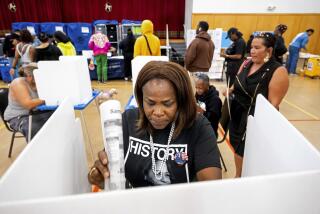Statistically Speaking, Florida Is a Toss-Up
- Share via
The presidential race is a statistical dead heat. There is no accurate way to tell who has won, and while the legal challenges from both sides have exposed weaknesses in the Florida electoral process and raised constitutional issues, the entire election remains a draw.
Imagine the following experiment at a Los Angeles Dodgers home game: Upon entry to Dodger Stadium, 500 fans are given blue cards and 500 are given red cards. At the end of the game, the 1,000 participants turn in their cards to ushers at the exit gates in exchange for free tickets to a future game. The ushers turn in their cards to a central authority and are awarded $1 per card delivered. The return cards are tallied by well-paid individuals.
Statistically, we know that the result would doubtless be 490-odd red cards and a similar number of blue cards. The probability of honest error is so well known that even a count in which one or both colors ended in excess of 500 would not be surprising. Even if we knew that half the people wished to vote red and half wished to vote blue, the result would not be 500-500.
The mechanics of the voting process (especially in Florida) are no more accurate than this experiment. In Florida, the system was designed to ensure fairness and optimal performance of this electoral apparatus. Since it appears that the voters are just about evenly split, there is near certainty that one of the candidates is going to emerge the winner.
It is on the basis of the number of votes clearly within the margin of error that a winner in Florida--and the next president of the United States--will be selected. The process is not intrinsically unfair; it is just random. It can never be clear which one of the two candidates received as much as 5,000 votes more than the other.
The current (certified) vote tally places Bush above Gore by 537 votes out of about 6 million cast. This (trust us on the math) purports accuracy of one part in 10,000. This is mathematically nearly impossible.
Try another experiment: take 500 sheets of paper. Tear each sheet into 20 pieces. Make a big pile. Count the pieces in the pile. Have your friends recount the pile. What is likely to emerge is a number that is not even within 10 of 10,000 (up or down); that is, accuracy of less than one part in 1,000.
In light of these observations, the behavior of both political candidates and their advisors, spokespersons, followers and lawyers is both reasonable and understandable. Both candidates have every right to those 25 electoral votes, and both candidates should execute every legal maneuver to get them. Nor is it surprising that in one place, the parties have taken positions taken by their opponents in another. Principle has been lost.
George W. Bush may win this election because a Republican legislature is poised with gavel raised to certify an election the instant that it is legally permissible to do so. Or Al Gore may win in the end because it turned out that this certification was not so legal after all, and meanwhile he had cleverly maneuvered so that only the Democratic strongholds would be manually recounted. Either outcome represents the will of the Florida voters. Indeed, the election is too close to call, so the question of who really got more votes is not material.
Are there any alternatives? One possibility is to follow the spirit of New Mexico electoral law. There, elections that are tied must be decided by a game of chance. Even a toss of the coin to decide Florida would be no less arbitrary than what has already happened or what is soon to happen. And furthermore, a coin toss or a game of chance would be less subject to criticism concerning partisan influence on the judicial or legislative process.
Joking aside, there are two realistic possibilities for how to resolve such difficulties in the future. First, insist that we use existing technology, such as that used in automatic teller machines, for the accurate counting of votes. Technology of the caliber used in these ATM machines will be costly but worth it in terms of the importance of assuring that voters are not disenfranchised. The other alternative, when an election is too close to call, is to simply divide a state’s electors evenly. This would in effect cancel out a state’s vote in the rare cases like Florida, but it would not be unfair to the candidates.
More to Read
Get the L.A. Times Politics newsletter
Deeply reported insights into legislation, politics and policy from Sacramento, Washington and beyond. In your inbox twice per week.
You may occasionally receive promotional content from the Los Angeles Times.










